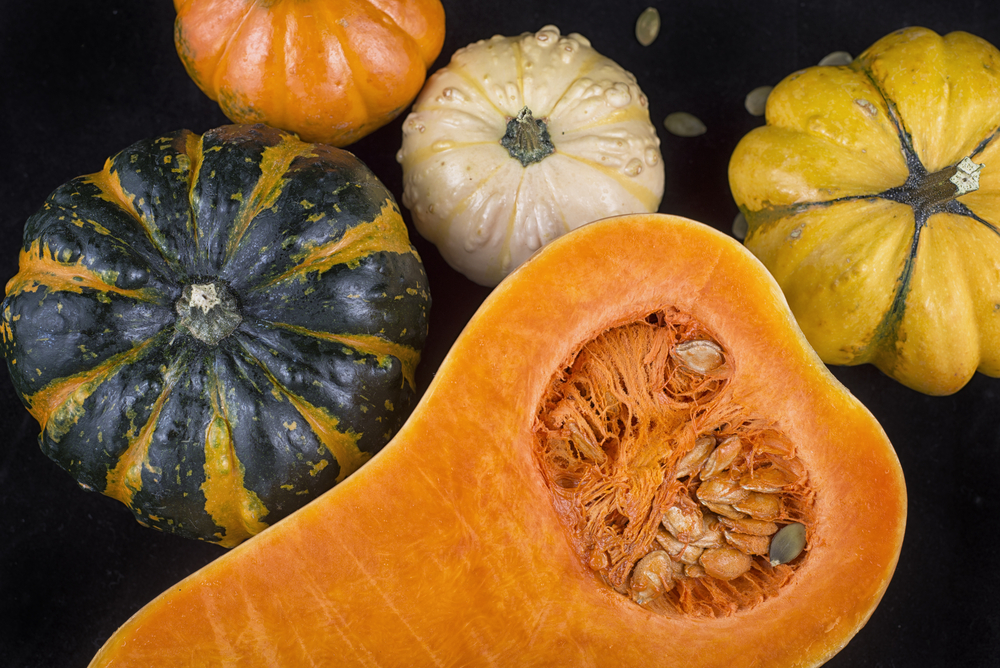
Move over, pumpkin - you aren’t the only squash in town. While pumpkin is the beloved flavor of fall (seriously, try finding something that’s not pumpkin-spiced this time of year), don’t forget the rest of the pumpkin family, especially squashes.
While actually considered fruit, pumpkins and squashes are extraordinarily versatile and can be used to make much more than just pie and sweet loaf breads. In fact, squashes can be made into almost anything. Whether you have a hankering for a creamy soup, pancakes, or risotto, squash can shine as the main ingredient.
So when you hit the grocery stores and farmers markets this fall, instead of hurrying right to the pumpkins, take the time to explore the squashes. These winter squashes keep well and have a lot of great vitamins.
And yes, it’s okay if you sip that pumpkin spice latte while checking out the squashes. They’ll never know.
Butternut Squash
In the past few years, the butternut squash has gained quite the following (and for good reason). Best known for that smooth, creamy butternut squash soup, butternut squash boasts a sweet yet nutty flavor reminiscent of its cousin, pumpkin. Oblong with tan-yellow skin, the butternut squash ripens to a deeper orange with a sweeter and richer taste. Butternut squash is most often used like a vegetable or starch in a meal, easily being prepared in a variety of ways, both savory and sweet.
Nutrients: High Fiber, Vitamin C, Magnesium, Potassium, Vitamin A, and Vitamin E
Acorn Squash
Most often used as decor, the acorn squash hides a yellow-orange center behind its dark green ridged exterior, and that much delicious deservest to be front and center on your table.The acorn squash has the shortest shelf life of winter squashes, but it can easily double as the main meal and dessert. With a mild flavor, somehow buttery yet sweet, the acorn squash compliments both savory and sweet dishes. My personal fave? A sage and seasonal sausage-stuffed acorn squash that is roasted to perfection.
Nutrients: High Fiber, Potassium, Vitamin A, Calcium, B Vitamins, Folate, Vitamin C, Magnesium, Iron
Sweet Dumpling Squash
The sweet dumpling squash is often used alongside the pumpkin centerpiece of autumn decorations. However, it’s just as useful to eat as to decorate. Often white with mottled greens, yellows, and orange markings, this pretty, seemingly miniature pumpkin has a sweet flavor when cooked. Whether roasted or stuffed, the sweet dumpling squash can steal the meal while being a seriously healthy option.
Nutrients: High Fiber, Vitamin A, Vitamin C, and B Vitamins
Spaghetti Squash
Sometimes the size of a football, a spaghetti squash brings a bright yellow to autumn decor. But this fun squash doesn’t have “spaghetti” in its name for nothing. When cooked, the flesh of the squash comes away in long ribbons, mirroring the appearance of spaghetti noodles. Naturally, spaghetti squash is often paired with tomato sauce, but many other flavor options exist for this playful squash, and I can’t help but recommend a spaghetti squash dish served with parmesan and sauteed mushrooms. Yum!
Nutrients: High Fiber, Vitamin A, B Vitamins, Vitamin C, Vitamin E, and Vitamin K
Pumpkin
Everyone knows pumpkin, but do you only use it to add seasonal flair to your decor? Did you know that there are more than 45 varieties of pumpkin and that it’s grown on every continent except for Antarctica? Crazier still, every part of a pumpkin is edible. You can eat the seeds, pulp, flesh, skin, leaves, and stem! Instead of just pumpkin pie this fall, try pumpkin lasagna, pasta, or soup. Make this year the year that pumpkin flavors are celebrated in all forms!
Nutrients: High Fiber, Vitamin A, Vitamin C, and Vitamin E

